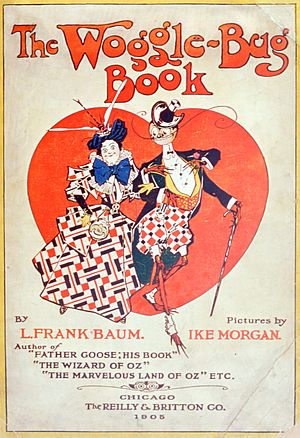The Woggle-Bug Book facts for kids

first edition cover
|
|
| Author | L. Frank Baum |
|---|---|
| Illustrator | Ike Morgan |
| Country | United States |
| Language | English |
| Genre | Children's book Humor Fantasy |
| Publisher | Reilly & Britton |
|
Publication date
|
1905 |
| Media type | |
| Pages | 48 pp. (unpaged) |
The Woggle-Bug Book is a children's book from 1905. It was written by L. Frank Baum, who also created the famous Land of Oz stories. The pictures in the book were drawn by Ike Morgan. For a long time, this book was very hard to find. It is known for its funny, sometimes silly, adventures of a character called the Woggle-Bug.
Contents
About the Book's Creation
This book came from a popular comic strip called Queer Visitors from the Marvelous Land of Oz. This comic strip helped promote Baum's second Oz book, The Marvelous Land of Oz (1904). In the comic strip, characters like the Scarecrow and the Tin Woodman visited the United States.
The Woggle-Bug Book uses a similar idea. It shows H. M. Woggle-Bug, T. E. trying to get used to life in an American city. The artist, Ike Morgan, was a cartoonist from Chicago. He had also drawn pictures for Baum's American Fairy Tales (1901).
The Woggle-Bug was a very popular character back then. People loved him so much that there were Woggle-Bug postcards, buttons, and even a song. A Woggle-Bug board game was also made by Parker Brothers. This picture book was released in January 1905. It helped advertise a new musical play called The Woggle-Bug. The book had many colorful pictures and text on almost every page. It was printed in a large size, about eleven by fifteen inches.
The Woggle-Bug's Adventure
The Woggle-Bug Book is full of broad humor that was common in its time. The Woggle-Bug loves fancy, bright clothes. He wears "gorgeous reds and yellows and blues and greens." He even carries a pink handkerchief!
One day, he sees a colorful dress in a department store window. It's on a mannequin. Being a Woggle-Bug, he has trouble telling the difference between the dress and the person wearing it. The dress is on sale for $7.93. To buy it, the Bug works as a ditchdigger for two days. He earns double pay because he has four hands!
But he arrives too late. The dress has already been sold. It then moves through different owners. The Woggle-Bug chases after his beloved dress all over town. He tries to talk to the different people who own the dress. His chase accidentally leads him on a balloon flight all the way to Africa!
In the jungle, he meets talking animals, which are common in Baum's imaginative stories. The Bug eventually finds his way back to the city. He has a necktie made from the dress's colorful fabric. He then feels happy and content, saying:
- "After all, this necktie is my love – and my love is now mine forevermore! Why should I not be happy and content?"
Some parts of this story are similar to other Baum books. For example, an accidental balloon flight took the Wizard to Oz in Baum's most famous book.
Funny Moments in the Story
The book has many silly and absurd moments. For example, when the Woggle-Bug is in Africa, he meets a charming Miss Chimpanzee. She helps him understand jungle life. Miss Chimpanzee has a funny opinion about humans:
- "Those horrid things they call men, whether black or white, seem to me the lowest of all created beasts."
The Woggle-Bug replies, "I have seen them in a highly civilized state, and they're really further advanced than you might suppose."
The Bug also gets his fortune told by a hippopotamus. The Hip says:
- "You think you have won; but there are others who have 1, 2. You have many heart throbs before you, during your future life. Afterward I see no heart throbs whatever. Forty cents, please."
The king of this jungle is a weasel, not a lion. This weasel king likes insults and face slaps instead of flattery! His kingdom is guarded by bears with guns. They form a "bearier" or "bearicade" and "oblige all strangers to paws."
Later Versions of the Book
After many years, a black and white copy of The Woggle-Bug Book was printed again in 1978. The story was also included in The Third Book of Oz in 1989. A newer version of this, called The Visitors from Oz, came out in 2005. Another copy of the book was printed in Oz-story Magazine in 1999. The book was printed again in 2008.

